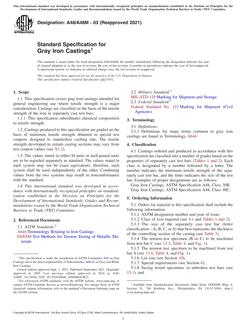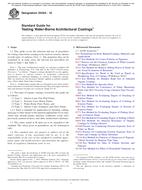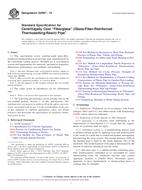1.1 This guide recommends the criteria to be considered in specifying removable insulation covers for surfaces operating in air at temperatures above ambient.
1.2 A removable insulation cover is fabricated from a fibrous insulation material encased in a tailored fabric or wire mesh enclosure, or both. The fabric seams are typically held together with thread, metal rings, or staples, or combination thereof. These covers must be designed and fabricated to allow a close fit with tight joints over piping, elbows, flanges, valves, and tanks. They are intended to be easily removed and replaced to allow for periodic access to the surfaces they cover.
1.3 In addition to thermal performance, there are other performance requirements of removable covers. These may include, but are not limited to:
1.3.1 Temperature exposure,
1.3.2 Chemical and weather exposure,
1.3.3 Acoustical, and
1.3.4 Fire endurance.
1.4 The materials from which the cover is made may include, but are not limited to:
1.4.1 Insulation media,
1.4.2 Fabric, metal mesh enclosure, or foil enclosure,
1.4.3 Seam materials (thread, metal hooks, etc.), and
1.4.4 Attachment system (hook and loop attachment, straps, wire, etc.).
1.5 The shape, size, and physical design of the cover varies depending on the object to be covered. The cover may consist of more than one piece. Pipes, valves, pumps, and flanges are typical objects to be covered. In many cases, on-site measurements need to be made to ensure an acceptable fit.
1.6 The values stated in SI units shall be regarded as the standard. The values given in parentheses are provided for information only.
1.7 This guide does not intend to establish the criteria required in the design of the equipment over which removable insulation covers are used, nor does this guide establish or recommend the applicability of removable insulation covers over all surfaces.
1.8 It is the responsibility of the user, user’s agent, or both, to determine applicability of this guide to their specific application and to inform the equipment designer of the intent to insulate so that appropriate design criteria can be established.
1.9 This standard does not purport to address all of the safety problems, if any, associated with its use. It is the responsibility of the user of this standard to establish appropriate safety and health practices and determine the applicability of regulatory limitations prior to use.
1.10 This standard should be used to measure and describe the properties of materials, products, or assemblies in response to heat and flame under controlled laboratory conditions and should not be used to describe or appraise the fire hazard or fire risk of materials, products, or assemblies under actual fire conditions. However, results of this test may be used as elements of a fire risk assessment which takes into account all of the factors which are pertinent to an assessment of the fire hazard of a particular end use.
Product Details
- Published:
- 01/01/1993
- Number of Pages:
- 4
- File Size:
- 1 file , 24 KB


